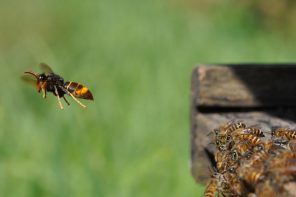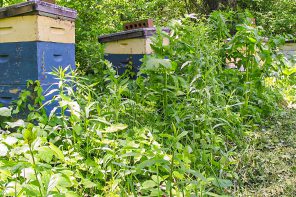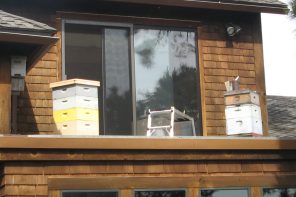Click Here if you listened. We’re trying to gauge interest so only one question is required; however, there is a spot for feedback!
Read along below!
Found in Translation
Mite Drop!
By: Jay Evans, USDA Beltsville Bee Lab
Varroa mites remain the primary source of honey bee colony losses for beekeepers managing from one to 10,000 colonies. Scientists like us and ardent beekeepers are always on the hunt for new ways to reduce varroa damage to bees and their colonies. One intriguing strategy is to make mites simply fall off their adult bee hosts. Short of changing the electric charge of host or parasite, this repellency can come from 1) making hosts less grippy, 2) somehow clogging the incredibly strong tarsi (feet with ‘toes’ and a spongy, oily, arolia) of mites or 3) affecting mite behavior by making them less likely to find safe spots and hang on to their bees for dear life. Dislodged mites are far more vulnerable to hygienic worker bees and might also simply keep falling down to a hostless, hungry and hopefully, short life. This is probably a central reason that female varroa mites spend very little time wandering the combs of beehives unless they are moments away from entering the brood cell of a developing bee. While on adult bees, mites have much incentive to stay right there, whatever their host is doing to drop them.
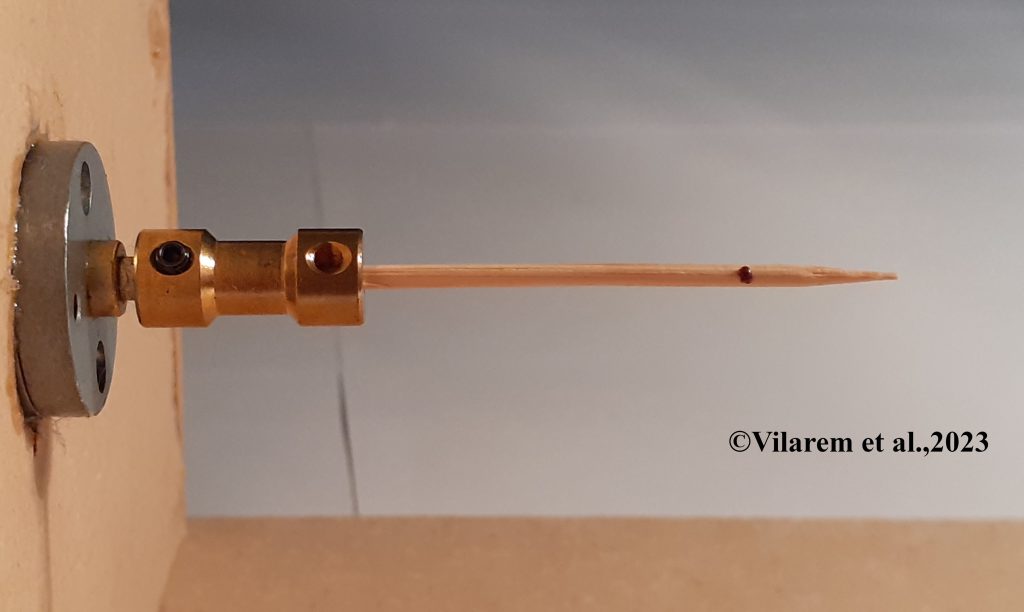 How do mites adhere to their bees so strongly? When mites are actively feeding on bees they are extremely hard to dislodge, since they are partly under the hardened plates of the bee itself and are gripping with a combination of ‘teeth’ and tarsi. Even while taking a break from feeding, mites know to find safe spots on the bee to attach, favoring locations on the abdomen or thorax that are both hairy and away from swinging legs and biting bee mandibles. How can one make them quit their bees given so many hiding places?
How do mites adhere to their bees so strongly? When mites are actively feeding on bees they are extremely hard to dislodge, since they are partly under the hardened plates of the bee itself and are gripping with a combination of ‘teeth’ and tarsi. Even while taking a break from feeding, mites know to find safe spots on the bee to attach, favoring locations on the abdomen or thorax that are both hairy and away from swinging legs and biting bee mandibles. How can one make them quit their bees given so many hiding places?
Caroline Vilarem and colleagues in France recently described an ambitious attempt to document the abilities of mites to hang onto surfaces when exposed to organic acids (Vilarem, C.; Piou, V.; Blanchard, S.; Vogelweith, F.; Vétillard, A. Lose Your Grip: Challenging Varroa destructor Host Attachment with Tartaric, Lactic, Formic, and Citric Acids, Appl. Sci. 2023, 13, 9085. https://doi.org/10.3390/app13169085). These scientists deployed one of the coolest low-tech tools to measure how well mites grip onto a surface. While their ‘Rotavar’ sounds both complex and expensive, it is actually a ‘motor-driven rotating toothpick’. Yes, you can do this at home, with a slow (three or so revolutions per minute) motor and a supply of toothpicks. The authors add to that an extremely careful experimental design and complex statistics to show the different abilities of mites to hang onto sticks and bees coated with acetic, citric, lactic, formic and tartaric acids. The results hint at new modes and new candidates for mite control, with the usual caveat that converting a controlled lab assay to field colonies will be challenging.
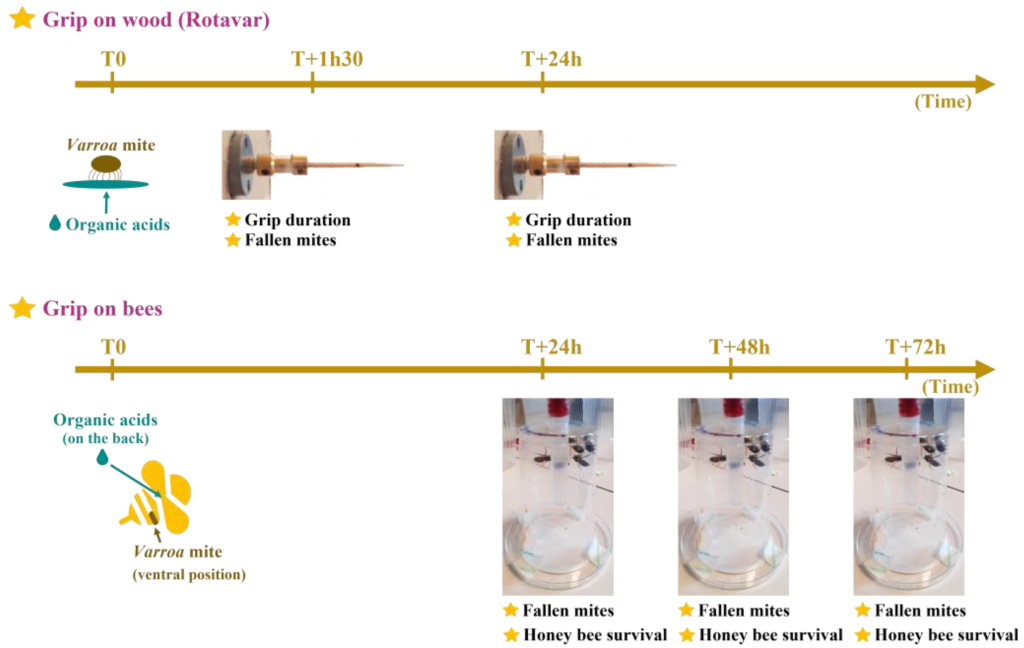
Schematic diagram of the experimental design and measured parameters. Grip on wood (Rotavar): This method relies on direct contact between Varroa’s arolia and the organic acids. The Rotavar set-up is a motor-driven rotating toothpick used to assess V. destructor’s grip. Grip on bees: the host attachment experiment applies acids to the backs of honey bees to remove mites. T0 represents the administration time for treatments; T + 1 h 30, 24 h, 48 h, or 72 h stand for the time post administration used to make measurements. Figure from https://doi.org/10.3390/app13169085
Some highlights: First, acidity itself does not seem to be the solution. Most notably, even high doses of acetic acid had little impact on the abilities of mites to grab toothpicks and this candidate was quickly discarded. So, what can we glean from the differences between the tested acids? Tartaric acid worked great at dislodging mites from spinning toothpicks but was surprisingly poor at dislodging mites from bees. Prior work suggests that the mode of action for tartaric acid is, at least in part, toxicity towards mites. It is possible that the levels of tartaric acid needed to coat bees with a toxic dose are higher than they are on a relatively smooth and barren toothpick. Toothpicks also attract watery compounds (hydrophilic) while bees are coated with oils and are hence more water-repellent (hydrophobic). Maybe the availability of tartaric acid on toothpicks is higher than it would be on oilier bee bodies. Formic acid also worked much better on the wood surface than on bees, an intriguing insight for a well-used and effective mite control. Formic acid is also known to be directly toxic to mites and their cells, and the authors make clear that both direct toxicity and grippiness are clear and perhaps synergistic targets for mite control. The widely used miticide oxalic acid also wins by being directly toxic to mites at levels that are relatively safe for bees, demonstrating that there are many possible ways to turn organic acids into effective treatments.
Lactic acid came out as the best candidate in the study group for divorcing mites from their bees. This acid worked well at dislodging mites from both toothpicks and bees. Lactic acid does not appear to be highly toxic to mites and instead seems to act by changing the mechanics of hanging on. This is a nice lead for exploring acids with similar qualities for their abilities to both grease the ‘Rotavar’ and make bees a more slippery host. In another intriguing result from this nice study, mites that simply walked across paper holding lactic acid were then less good in future grip tests. What is it about lactic acid that burns, cleans or otherwise insults the complex and surprisingly ‘soft’ tarsi of mites?
If this topic has gripped you, consider reading up on the field thanks to a recent open-access paper on stickiness by graduate student Luc van den Boogaart and colleagues in the Netherlands (van den Boogaart, L.M.; Langowski, J.K.A.; Amador, G.J. Studying Stickiness: Methods, Trade-Offs, and Perspectives in Measuring Reversible Biological Adhesion and Friction. Biomimetics 2022, 7, 134; https://www.mdpi.com/2313-7673/7/3/134). For those of us who have stored ‘Freshman Physics’ in a remote hard drive, they give a clear review of how these forces work across organisms; in their words ‘from ticks to tree frogs’. Maybe their figures and insights will inspire a beekeeper or scientist to dream up a safe, effective route to dislodge mites from bees and prevent them from climbing back on. Pulling in people with a knowledge of physics, or just really good imaginations and the ability to build and deploy Rotavars (imagine how entertaining those can be, a la squirrel spinners… https://www.youtube.com/shorts/nBKb_z4_tGY), can only help in the hunt for new mite controls and healthier bees.







